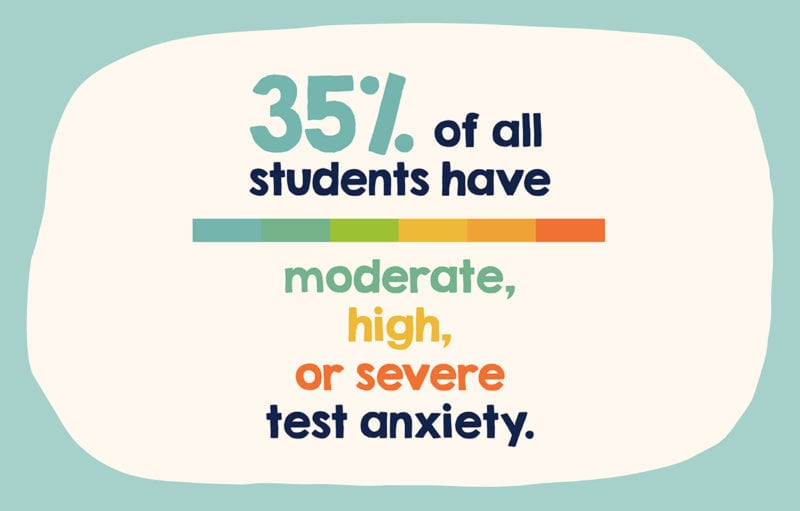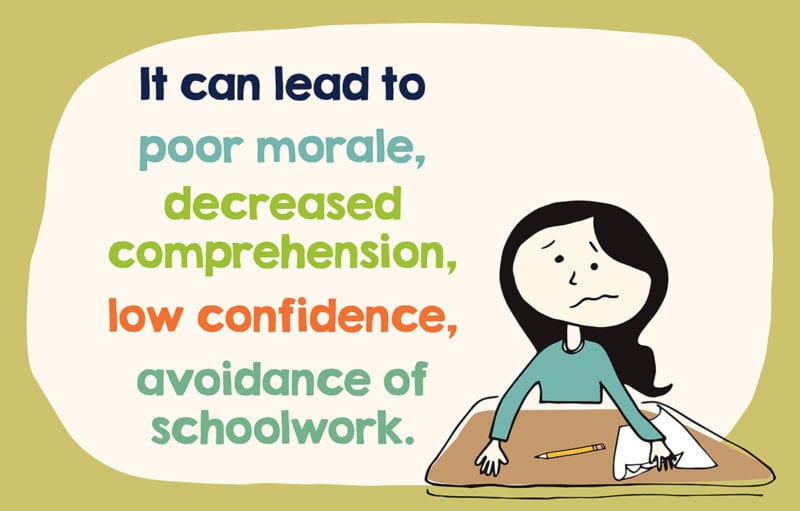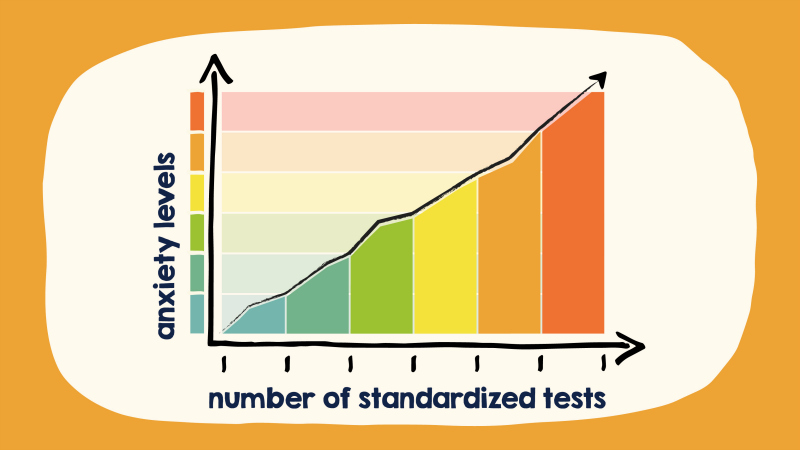Test anxiety is the number one learning challenge of students today, affecting more than 10 million kids in North America. Test anxiety is not anxiety per se, though it is related to performance anxiety. And it’s not a learning disorder, though many kids with learning disorders have it.
Test anxiety is its own beast that shows up in students of all ages at testing time. Students can be 100% prepared and ready but then are debilitated when they sit down to take the test. Take a look at the facts in this video below.
Testing has been on the rise, especially in the last 10–15 years. A study from the Council of the Great City Schools found that students will take about 112 standardized tests from pre-K through 12th grade. And researchers are proving that there’s definitely a link between the increase in frequency of standardized tests and test anxiety.
Educators see it every single day, which is adding to their stress, too. We have teachers, like Mary*, who have a whopping 40% of their personal evaluation based on students’ test scores. There are schools, like Allison’s, who have important funding tied to their test scores, so admins cut things like recess, art, and even lunch time to give extra minutes for test prep.
There are teachers, like Mark, who wake up in the middle of the night, unable to stop worrying about testing: Did I prepare my kids enough? Is Marcus going to get yelled at by his dad if he doesn’t do well? Am I going to lose my job if scores dip this year?
And we have confusing and baffling scenarios, like Kate’s. She’s a SPED teacher, and though her students can’t read or understand the concept of testing, they take the same tests as their peers. Those days often end up with Kate’s students in tears, but all she can do is watch helplessly, since strict rules restrict her from helping in any way.
So what’s the solution?
It’d be easy to say we should have fewer tests and more trust in our teachers. It’s tempting to blame lawmakers or say we need to overhaul the way we look at testing in schools today. But whether you agree with these statements or not, they won’t help teachers giving standardized tests next month. And it won’t address the 35% of students in North America who report having moderate, high, or severe test anxiety.
To better understand test anxiety and get tips for dealing with it, we spoke with educational experts around the country who see it every day. These professionals work with parents, students, and teachers, hoping to improve the statistics overall. Here are their 10 best tips for helping your students.

1. Understand and embrace the good parts of stress.
Christopher S. Rozek is the lead author on a recent study by the Department of Psychology at Stanford University, and he found that giving students an alternative perspective to stress and anxiety can be really helpful in helping them cope with it. They found that just understanding anxiety can improve test scores, especially in students from lower-income backgrounds.
“In our study we helped students look at how anxieties can be valuable,” he says. “We showed them you can actually use certain anxieties to help yourself do better on a test.”
Rozek is talking about things like a fast heartbeat, nervousness, and even sweaty palms. All can be a sign of anxiety, but when you understand them better, you realize they can actually help you.
Give your students a different point of view. “It’s perspective really,” Rozek says. He says teachers can be the leaders in helping students switch their viewpoints. For instance, let students know that a fast heartbeat can be a positive sign. It can actually tell your brain that you’re excited, and it helps get you be mentally prepared for the test.
Talk about anxiety, even at a young age. Test anxiety can happen at any age, but since it peaks early on (usually in grades 2–4), teachers shouldn’t be afraid to have the conversation. Here are some good books on anxiety to check out.
[contextly_auto_sidebar]
2. Give students an outlet through journaling.
Another tip from Rozek is to have students write about their worries ahead of time.
“Writing about your anxieties can help you gain insight about them,” he says. “It doesn’t totally get rid of all of your anxieties, but it can help offload them.”
Journaling and writing have been used for years to help us cope with and relieve stress, and Rozek says this can work prior to testing, too. By encouraging journaling, you can let students express their concerns openly instead of keeping them bottled up.
Talk about why writing helps. Don’t be afraid to talk to your students about how writing has made you feel better and lessened your worries overall.
Practice it regularly. If you need ideas, here are some writing prompts for building self-esteem and confidence.
3. Practice mindfulness regularly, not just during stressful times.
Marisa LaDuca Crandall has worked for years as a school psychologist, and she knows there’s a lot of high-stakes testing in schools today, leading to more test anxiety. She says one of the best ways to combat this is through mindfulness.
“When you practice mindfulness every day, it actually helps train the prefrontal cortex of your brain to learn how to deal with anxiety and stress,” she says. “If you practice it regularly, even in stressful situations, it can help create a positive association instead of a negative one.”
Make it a daily activity. Even a minute in the morning and a minute after lunch can go a long way in creating a good mindfulness practice for students. Then they’ll start to understand how to do it on their own.
Try breathing, books, and other ideas. Here’s an article on bringing mindfulness into the classroom for students AND teachers.
4. Make accommodations when necessary.

Imagine you’re taking a test and suddenly your brain seems to freeze. You can’t remember anything—you even struggle to understand the words you’re reading on the page. This is a very real scenario, and when this happens, students can feel completely trapped by their surroundings.
So what can a teacher do? If an anxiety attack suddenly comes on, sitting in a quiet room and watching the seconds tick by doesn’t help. Even with testing rules and regulations that need to be followed, Crandall says teachers should have a plan in place when this happens to a student.
Work with your principal and admin to give students an option. This is important. Let them pause, get a drink, or go out to the hallway for a moment.
Remove the student from the environment. Let students take their test in an office or a separate room.
5. Kids need more physical activity and sleep, especially before a big test.
“It might sound silly to prescribe things that we already know we should be doing,” Crandall says. “But we aren’t doing them.”
This area definitely needs the support of families, but Crandall says there are ways schools can get involved, too. “We need to give time for it during the school day,” she says. “We can’t just tell kids to do stuff without giving them time to do it.”
Add in more recess during testing. If you’re going into a big testing week or if you’re in the middle of one, be an advocate for your students. Make sure they’re getting their outdoor and recess time. It actually helps test scores!
Encourage brain breaks. This is another practice that is good to do year-round. It helps students recognize when they need a break and then take it.
Keep reminding parents. Sleep, a good breakfast, and overall rest are all messages worth repeating.
6. Expose kids to an actual testing environment—stressors and all.
Simulation is an effective tool to use for test prep, and one of the most important parts of it is to make it authentic.
“This falls under exposure therapy,” Crandall says. “If you can create a simulation where you actually go through it, you can help manage the anxiety.”
Try to replicate the scenario as much as you can. If it’s a timed test, time your students. If it’s an early morning test, be sure to do a trial at that same time.
Talk about it when you’re done. If you do try a simulation activity, talk to your students after it’s over. Ask them how they felt. Help them see that it’s fine to feel a little anxiety but that they can move past it and still do great.
7. Get your principal on board to make it a school-wide effort.
Principal support is key for any classroom concern, and it’s certainly true for dealing with test anxiety.
“You need a good principal,” says Dr. Richard Driscoll, the founder of the American Test Anxieties Association. “A good leader that understands the concerns and offers solutions can do so much to help teachers.”
So how can your principal help?
Get the entire district involved. Communicate with other stakeholders about the issue of test anxiety and identify solutions for your community.
Communicate to parents. Talk with parents about testing and help to place it in the right context.
Give teachers the tools they need, including the authority to make accommodations when needed.
8. Collaborate with parents.
In some cases, parents are making demands of teachers and adding to their children’s stress, often without even realizing it. This is something Annmarie Chereso, founder of the organization BringIt! Home, knows all too well as a mindfulness coach in Chicago schools.
She says it’s important to remember that parents can also be an ally in the process. Here are some collaboration opportunities:
Give pointers for how to talk about testing at home. Tell parents about test anxiety and give them explicit ways to talk about testing that relieve some of the pressure. Suggest that they say things like, “These tests don’t measure who you are as a person,” for example.
Build trust in the parent-teacher relationship. Keep the lines of communication open through email, social media, class newsletters, etc. Sometimes parents just need that reminder that you’re all in it together.
Conquer the what-if scenarios with students and parents. “Anxiety is just fear of something that might or might not happen in the future,” says Chereso. She suggests talking with students and parents about those what-if fears. Sometimes just recognizing them and accepting them is a good first step.
9. Work on your own test-related anxiety.

Students absolutely pick up on feelings of anxiety, stress, and worry, and they’ll replicate it in their own behavior. Scientifically, it’s known as mirror neurons, and it’s something kids learn to do even as babies.
This same behavior can hold true for test anxiety. “Kids are like sponges,” Chereso says. “If an adult is showing up in the environment with fear or anxiety—even if they’re not speaking it—our children will notice this and reflect it back.”
There is no doubt teachers have a lot of their own stress and anxiety, and the growing emphasis and demands in testing certainly don’t help. But Chereso says the first step is to acknowledge it, just like you would encourage your students to do.
Work through it, but not in front of the kids. “It’s okay to have anxiety around testing,” Chereso says. “But try to process it away from them so you can show up in a way that’s clean for students.”
Implement your own mindfulness practice. She recommends regular mindfulness for adults, just like you would do with students. Testing (and the other stresses of being a teacher) might not be going away anytime soon, but you can learn how to better cope with it every single day.
10. Speak up, even when you’re not sure anyone is listening.
Teaching can feel lonely, frustrating, and ever challenging, especially when you look at the testing in schools. But all of our experts agree that we shouldn’t stop talking about test anxiety and finding ways to improve it.
We need to keep talking about it for Christina, a third grade teacher who says the hardest part of her job is those awful conversations she has to have every year—where she tells kids (and their parents) they’ll have to repeat the third grade.
We need to keep talking about it for Alex, who says his coworkers have grown to despise their administration because of the unrealistic expectations and tracking they put in place in an attempt to raise test scores (instead of addressing the real problems).
And finally, we need to keep talking about it for the kids. The kids who call in absent on testing day because they can’t even function. The ones who worry themselves so much that they throw up. And, as Tina points out, the ones that will grow up to become teachers, politicians, and difference makers who can make an impact on the future.
*All teacher stories in examples in this article are true accounts, but names have been changed for privacy.
Have you dealt with test anxiety in you classroom? Come and share in our WeAreTeachers HELPLINE group on Facebook.
Plus, why we need to do more for teachers who are exhausted, stressed, and burned out.


